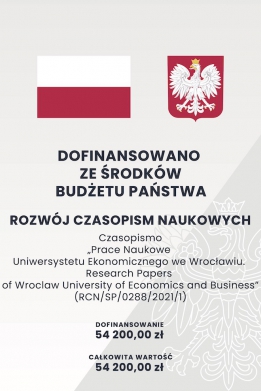Virtuality and Trust: The Impact of Team Virtuality Level on Trust Relations Between Leaders and Team Members
DOI:
https://doi.org/10.15611/pn.2025.1.07Keywords:
leadership, global virtual teams, trustAbstract
Aim: The aim of the study is to identify and analyze the relationship between the level of team virtuality and the level of trust that a leader places in their team members.
Methodology: The study was conducted using the CAWI (Computer-Assisted Web Interview) method. The research group included leaders of international corporations who had individual profiles on the LinkedIn platform. The respondents were asked to complete an electronic form containing survey questionnaires. All questions were presented in English.
Results: The study results showed that certain aspects of virtual collaboration, such as working across different time zones, have positive correlations with some trust factors. Conversely, other factors, such as the lack of face-to-face interaction and different methods of work monitoring, pose challenges to building trust.
Originality/value: This article contributes to research on trust in virtual teams by presenting an analysis of trust from the leader’s perspective, focusing on the leader’s trust in the team and exploring the relationship between different dimensions of virtuality and trust factors.Downloads
References
Alward, E. i Phelps, Y. (2019). Impactful Leadership Traits of Virtual Leaders in Higher Education. Online Learning, 23(3), 72-93.
Arling, P. A. i Subramani, M. (2011). The Effect of Virtuality on Individual Network Centrality and Performance in On-Going, Distributed Teams. International Journal of Internet and Enterprise Management, 7(4), 325. https://doi.org/10.1504/IJIEM.2011.045111
Benda, A. N., Kramer, W. S., Baak, M. E., & Feitosa, J. (2023). Understanding Trust in Virtual Work Teams. In L. L. Gilson, T. O’Neill & M. T. Maynard (Eds.), Handbook of Virtual Work (pp. 305-324). Edward Elgar Publishing.
Bierly, P. E., Stark, E. M., i Kessler, E. H. (2009). The Moderating Effects of Virtuality on the Antecedents and Outcome of NPD Team Trust. Journal of Product Innovation Management, 26(5), 551-565. https://doi.org/10.1111/j.1540-5885.2009.00680.x
Breuer, C., Hüffmeier, J., Hibben, F., i Hertel, G. (2020). Trust in Teams: A Taxonomy of Perceived Trustworthiness Factors and Risk-taking Behaviors in Face-to-Face and Virtual Teams. Human Relations, 73(1), 3-34.
Campagna, R. L., Dirks, K. T., Knight, A. P., Crossley, C., i Robinson, S. L. (2020). On the Relation between Felt Trust and Actual Trust: Examining Pathways to and Implications of Leader Trust Meta-Accuracy. Journal of Applied Psychology, 105(9), 994.
Chamakiotis, P., Panteli, N., & Davison, R. M. (2021). Reimagining E-leadership for Reconfigured Virtual Teams due to Covid-19. International Journal of Information Management, 60, 102381.
Chudoba, K. M., Wynn, E., Lu, M., i Watson-Manheim, M. B. (2005). How Virtual Are We? Measuring Virtuality and Under-standing Its Impact in a Global Organization. Information Systems Journal, 15(4), 279-306.
Crisp, C. B. i Jarvenpaa, S. L. (2013). Swift Trust in Global Virtual Teams: Trusting Beliefs and Normative Actions. Journal of Personnel Psychology, 12(1), 45-56. https://doi.org/10.1027/1866-5888/a000075
Dirks, K. T. i de Jong, B. (2022). Trust within the Workplace: A Review of Two Waves of Research and a Glimpse of the Third. Annual Review of Organizational Psychology and Organizational Behavior, 9, 247-276.
Flavian, C., Guinalíu, M., i Jordan, P. (2019). Antecedents and Consequences of Trust on a Virtual Team Leader. European Journal of Management and Business Economics, 28(1), 2-24.
Ford, R. C., Piccolo, R. F., & Ford, L. R. (2017). Strategies for Building Effective Virtual Teams: Trust Is Key. Business Horizons, 60(1), 25-34.
Foster, M. K., Abbey, A., Callow, M. A., Zu, X., i Wilbon, A. D. (2015). Rethinking Virtuality and Its Impact on Teams. Small Group Research, 46(3), 267-299. https://doi.org/10.1177/1046496415573795
Gelston, G. M., Wells, C., i Dalton, A. (2018). Virtual Leadership in Complex Multiorganizational Research and Development Programs. 2018 IEEE Conference on Cognitive and Computational Aspects of Situation Management (CogSIMA), 97-102. https://doi.org/10.1109/COGSIMA.2018.8423974
Hacker, J. V., Johnson, M., Saunders, C., & Thayer, A. L. (2019). Trust in Virtual Teams: A Multidisciplinary Review and Integration. Australasian Journal of Information Systems, 23, 1-36.
Handke, L., Costa, P., & Feitosa, J. (2024). How Virtual Are We? Introducing the Team Perceived Virtuality Scale. Journal of Business and Psychology, 40, 455-478. https://doi.org/10.1007/s10869-024-09966-3
Jagoda, A. (2010). Problemy zarządzania zespołem wirtualnym w przedsiębiorstwie globalnym. Studia i Prace Kolegium Zarzą-dzania, 88.
Kirkman, B. L. i Mathieu, J. E. (2005). The Dimensions and Antecedents of Team Virtuality. Journal of Management, 31(5), 700-718.
Koźmiński, A. K. (2013). Ograniczone przywództwo. Studium empiryczne. Poltext.
Krawczyk-Bryłka, B. (2013). Zaufanie w zespole projektowym a (kobiecy) model przywództwa. Przedsiębiorczość i Zarządzanie, 14, 117-130.
Krawczyk-Bryłka, B. (2016). Budowanie zespołu wirtualnego: Zasady i wyzwania. Studia Informatica Pomerania, 2(40), 99-111.
Liao, C. (2017). Leadership in Virtual Teams: A Multilevel Perspective. Human Resource Management Review, 27(4), 648-659.
Lukić, J. M., i Vračar, M. M. (2018). Building and Nurturing Trust among Members in Virtual Project Teams. Strategic Mana-gement-International Journal of Strategic Management and Decision Support Systems in Strategic Management, 23(3).
Morganson, V. J., Major, D. A., Oborn, K. L., Verive, J. M., & Heelan, M. P. (2010). Comparing Telework Locations and Traditional Work Arrangements: Differences in Work-Life Balance Support, Job Satisfaction, and Inclusion. Journal of Managerial Psychology, 25(6), 578-595.
Orhan, M. A. (2017). The Evolution of the Virtuality Phenomenon in Organizations: A Critical Literature Review. Entre-preneurial Business and Economics Review, 5(4), 171-188. https://doi.org/10.15678/EBER.2017.050408
Prystupa-Rządca, K. i Latusek-Jurczak, D. (2016). Role of the Virtual Team Leader: Managing Changing Membership in a Team. The Laws of the Knowledge Workplace (s. 93-110). https://doi.org/10.4324/9781315556215-13
Robert, L. P., Denis, A. R., & Hung, Y. T. C. (2009). Individual Swift Trust and Knowledge-Based Trust in Face-to-Face and Virtual Team Members. Journal of Management Information Systems, 26(2), 241-279.
Robert, L. P. i You, S. (2018). Disaggregating the Impacts of Virtuality on Team Identification. Proceedings of the 2018 ACM Conference on Supporting Groupwork (s. 309-321). https://doi.org/10.1145/3148330.3148337
Schmidt, G. B. (2014). Virtual Leadership: An Important Leadership Context. Industrial and Organizational Psychology, 7(2), 182-187. https://doi.org/10.1111/iops.12129
Schwabe, M. (2023). Zaufanie jako niezbędny element funkcjonowania organizacji. Studia i Prace Kolegium Zarządzania i Finan-sów, 189, 113-131. https://doi.org/10.33119/SIP.2023.189.7
Schweitzer, L. i Duxbury, L. (2010). Conceptualizing and Measuring the Virtuality of Teams. Information Systems Journal, 20(3), 267-295.
Sieben, B. (2007). Themed Article: Doing Research on Emotion and Virtual Work: A Compass to Assist Orientation. Human Relations, 60(4), 561-580.
Spiewak, S., Strojny, P. i Strojny, A. (2011). Wirtualne zaufanie: Wpływ komunikacji zapośredniczonej przez komputer na podejmowanie decyzji o współpracy w sytuacji dylematu społecznego. Czasopismo Psychologiczne, 17, 75-83.
Spreitzer, G. M. i Mishra, A. K. (1999). Giving Up Control without Losing Control: Trust and Its Substitutes’ Effects on Managers’ Involving Employees in Decision Making. Group i Organization Management, 24(2), 155-187.
Zand, D. E. (1972). Trust and Managerial Problem Solving. Administrative Science Quarterly, 17(229).
Downloads
Published
License
Copyright (c) 2025 Jakub Wojnar

This work is licensed under a Creative Commons Attribution-ShareAlike 4.0 International License.
Accepted 2025-04-02
Published 2025-05-28









